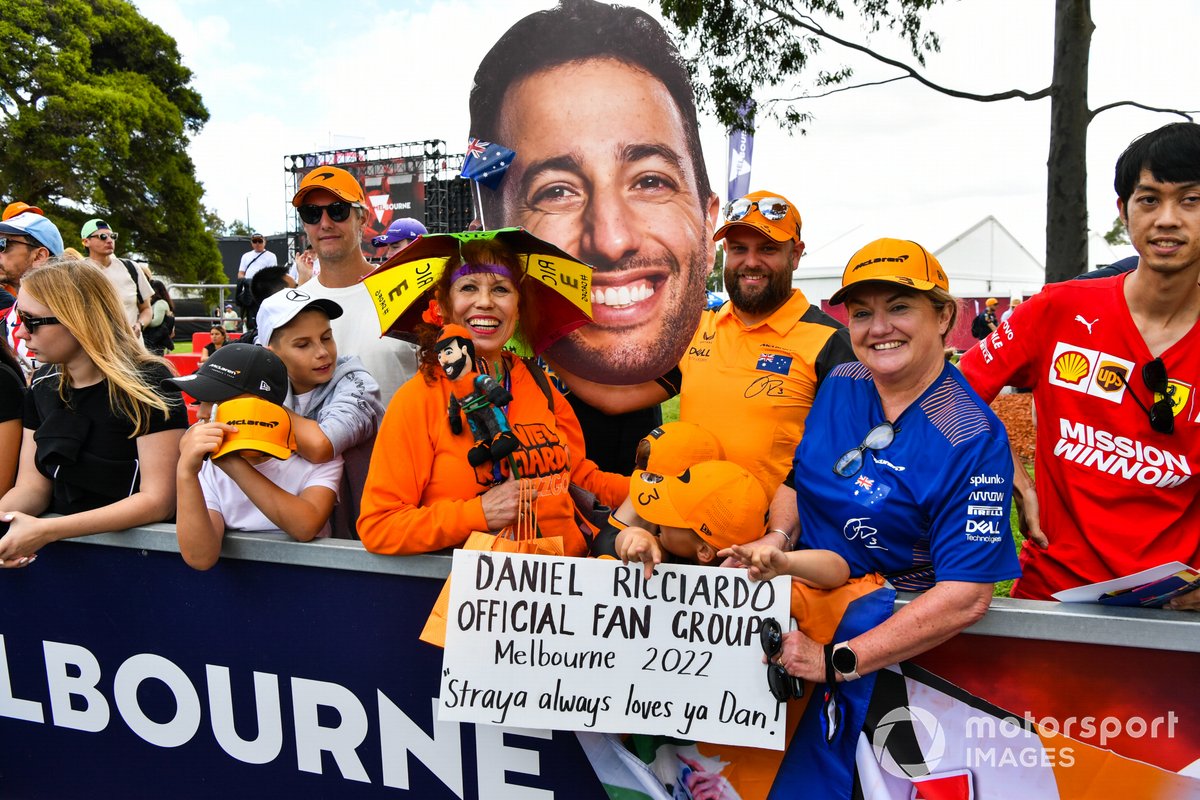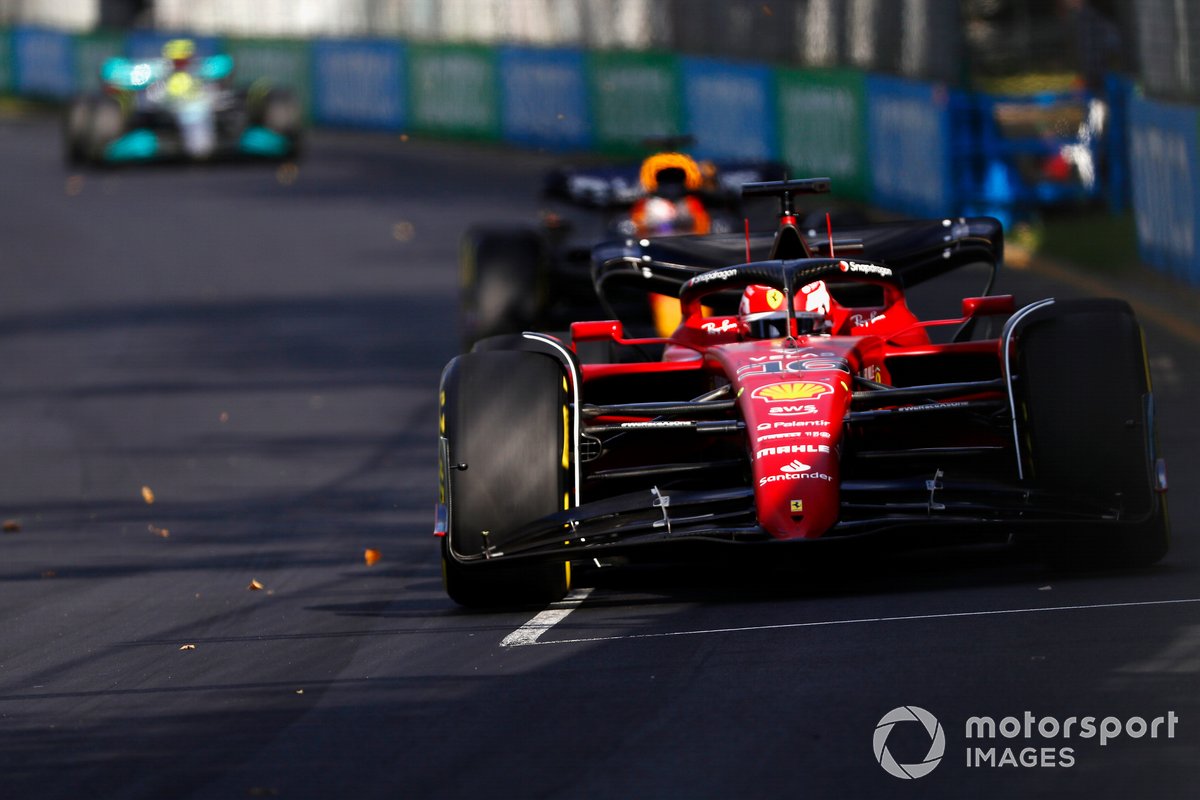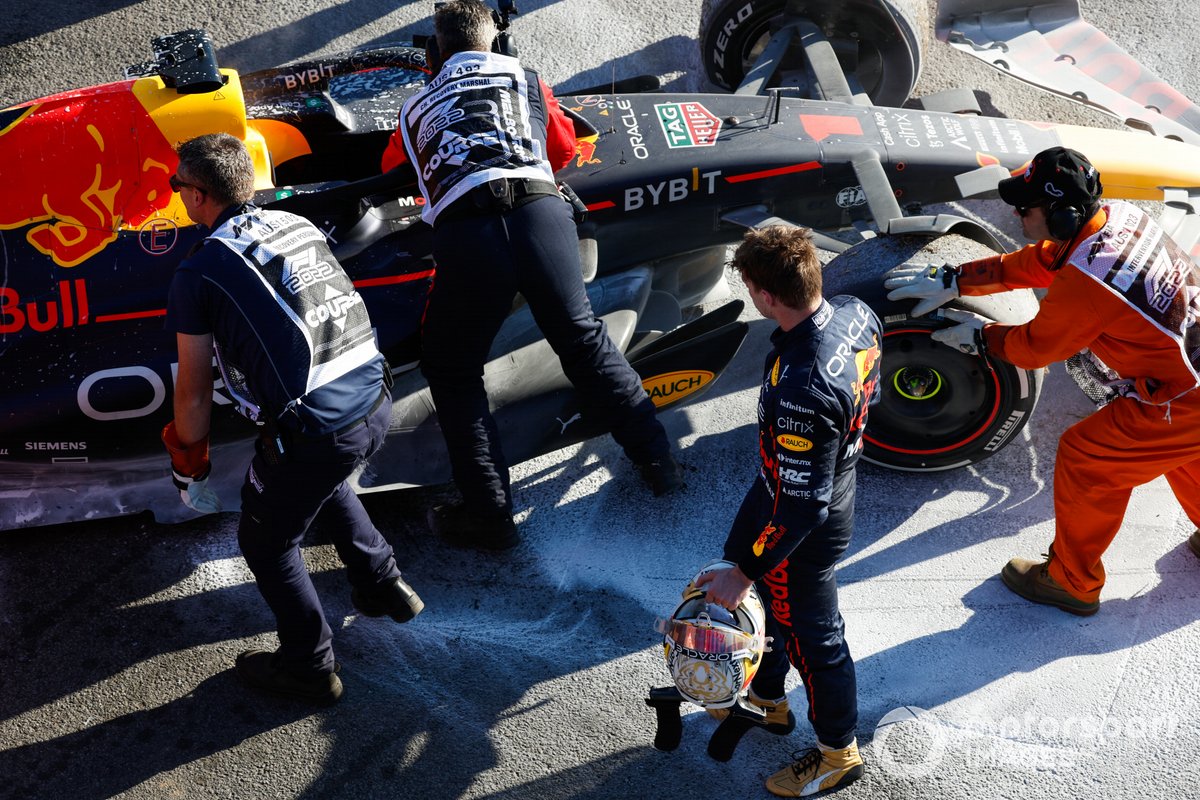
After the frenetic DRS duels that defined the 2022 Formula 1 season-opening Bahrain and Saudi Arabia Grands Prix, the return to Australia after three years without a race was a comparatively humdrum affair. Polesitter Charles Leclerc took control to land the victory.
The Ferrari charger launched cleanly to pull across the Albert Park circuit and cover off any potential lunges from his Red Bull chasers. Then the Monegasque retained a command over proceedings, marching away from eventual runner-up Sergio Perez and nabbing a bonus point for fastest lap. It was proof that the Italian team, while not infallible as it again battled porpoising, has bolted out the gates strongly at the start of the largest technical revamp in F1 history.
Reigning champion and chief rival in the early part of the new ground-effect campaign, Max Verstappen never quite looked as though he had enough in reserve to mount a charge for the win as he attempted at Sakhir and pulled off successfully in Jeddah. And then he was sent for an early bath with another fuel system fault aboard his Red Bull RB18.
Elsewhere, George Russell had the measure of Lewis Hamilton to land a podium, Williams and Alexander Albon scored a point with a lesson in tyre conservation and deft strategy, while McLaren found some form and Haas suffered a stumble.
Here are 10 things we learned from the 2022 Australian Grand Prix.

1. It was refreshing not to have a drama-filled weekend
Last Sunday’s race certainly won’t be remembered as one of the all-time greats. A thriller it was not, coming hot on the heels of Leclerc and Verstappen battling wheel-to-wheel on consecutive laps in Bahrain and Saudi Arabia. But that’s no bad thing.
First, everyone in the paddock seemed particularly buoyed by returning to Melbourne - the site of the late GP cancellation in 2020 amid what was then the outbreak of the coronavirus pandemic. And the shiny, facelifted Albert Park had an appetite for F1 to return, boasting a record crowd of 420,000 people over the weekend.
And the weekend ended a run of controversial form for F1. There was no collision between title rivals as per Jeddah in December. No safety car farce like that of Abu Dhabi, or the fallout and social media discourse that dogged the off-season. No missile strike, either.
The Australian GP wasn’t boring by any means, but nor was it an instant classic. However, few are coming away bitter and embroiled in a draining heated scandal. By that measure, it was a refreshing and welcome tonic.

2. Leclerc has developed into a driver who can control races from the front
Coming into the weekend, Leclerc was quick to refute claims that he is operating as a “2.0” version of himself this season. He fired back saying there had been a linear, year-on-year improvement and not a sudden step change that has coincided with Ferrari hitting the front.
That development was on show in the manner with which he took his fourth win in F1. His two successes prior to this season arrived in the consecutive Belgian and Italian GPs in 2019. In both, he faced great pressure from the chasing Hamilton and Valtteri Bottas in the closing stages to cross the line less with a lead of less than one second.
So far in 2022, he has proved his credentials in combat with Verstappen. But in Australia, he demonstrated the breadth of his skillset by taking command of proceedings and never looking as though he might let first place slip.
PLUS: How decisions Ferrari aced and Red Bull regretted led to Leclerc’s Melbourne masterclass
Other than a small moment of understeer during the second safety car restart, when his tyres cooled to give Verstappen his one and only sniff, Leclerc drove a perfect race and had pace to spare. This time, Verstappen couldn’t muster a sustained and genuine threat to the lead before his retirement. Pole, victory, fastest lap - this was Leclerc’s most complete weekend.

3. Red Bull is allowing Verstappen’s title defence to stutter
From the three rounds so far this season, it’s clear that Verstappen has been the closest challenger to Leclerc. And yet with two retirements sandwiching his win in Jeddah, the reigning champion sits only sixth in the championship and some 46 points off the Ferrari driver.
That gap is likely to close and, naturally, it’s still early days. Similarly, it would be unwise to take Russell’s current second place in the table at face value. But the faltering start for Verstappen, despite running Leclerc so close, does show where Red Bull is letting him down.
It’s not just the headline retirements, with another fuel system issue for a Red Bull-badged Honda powertrain hitting in Australia. The team’s set-up decision to favour low-drag and boost its top speed, it’s joker card in Saudi Arabia, meant Verstappen had a lack of balance in practice and that put his nose out of joint for qualifying.
And like his hard-tyre chagrin last time out, again the RB18 struggled to excite the Pirelli tyres as the Dutch ace faced graining in both stints before the ultimate unreliability. In his own words: “unacceptable”.

4. Mercedes is no closer to taking the fight to Red Bull and Ferrari
A lot of onlookers, both in and out of the paddock, weren’t buying it in pre-season testing when Mercedes was hurriedly playing down expectations. But it appears as though the eight-time constructors’ champion was on the money with its regression in 2022.
The more recent declaration, however, is that when the W13 car is unlocked, Mercedes will be back at the sharp end. But the potential in the machinery still remains only theoretical after the display from the Silver Arrows in Melbourne.
PLUS: The domino effect causing Mercedes' current F1 problems
The supertimes suggest Mercedes is falling further behind Ferrari and Red Bull. It had a deficit of 0.541s in Bahrain and 1.025s in Saudi. That has now increased further to 1.229s last weekend in Australia. What’s more, those numbers place its on-paper speed behind McLaren and Alpine.
Russell was able to pick up a podium and despite battling overheating, Hamilton came home fourth after pulling away from Lando Norris and Daniel Ricciardo in another weekend of effective damage limitation. But the headline results do not cover up that Russell was outqualified by Norris and he benefitted heavily from the second safety car before ceding to Perez to finish 26s adrift of winner Leclerc.

5. McLaren has made gains in a very unsettled midfield
Part of the success of the regulatory overhaul for 2022 has been the reintroduction of design differentiation into F1. One team’s take on the optimum ground-effect solution is very different to the next. That’s true of the whole pitlane. The knock-on effect of the variation appears to be that everyone behind Ferrari and Red Bull is still yet to establish where they sit in the competitive order.
Fifth and sixth for McLaren marked a significant leap forward after its toils in Bahrain and Saudi that were a long way adrift of the hype it created in pre-season testing. Fernando Alonso might have landed provisional pole before the hydraulics problem that induced his crash in qualifying on a weekend when Alpine jumped ahead of Mercedes in the supertimes.
By contrast, the Haas duo of Kevin Magnussen and Mick Schumacher were never a threat for Q3 or points despite the American team’s impressive start to the new campaign.
Albert Park was heavily updated for this year and the venue has never been a crystal-clear form guide in seasons gone by, but the change in pecking order last weekend hopefully previews the competitive swing that might occur from one track to the next as different layouts and surfaces come to suit different teams.

6. Albon and Williams defied safety car pitstop logic for a popular point
Williams scored its first point of the season thanks to Albon and the team’s strategists working in tandem to execute a deft late pitstop call after nursing hard tyres for 57 of the 58 laps.
The Thai-Brit qualified 16th but started last following his three-place grid penalty for causing a collision with Lance Stroll in Saudi Arabia and for failing to provide a fuel sample, which meant he was chucked out of the qualifying results. But he recovered to 10th at the flag by defying conventional wisdom.
PLUS: Australian GP Driver Ratings 2022
A pitstop under a virtual or full safety car was calculated to be around 12s in Australia, 8s quicker than stopping in normal race conditions. Having deviated from the main tactic by starting on hard tyres, logic might therefore have dictated that Albon stopped around lap 39 when the VSC was called for Verstappen retiring.
But he instead ploughed on until the end of the penultimate lap, keep the aging rubber alive and in a temperature sweet spot to keep competitive and not have to take advantage of the shortened stops.
Then when he made his very late visit to the pits, Leclerc was lapping and therefore delaying the cars Albon was battling for position to allow him to hang on for a points finish. Much to the delight of the cheering Williams garage.

7. If Vettel names his car after another Bond Girl, it should be ‘Jinx’
Sebastian Vettel has a penchant for naming his cars. To mark his first season at Aston Martin in 2021, he christened the AMR21 after the original Bond Girl ‘Honey Ryder’. And speaking to media on Friday at Albert Park, the four-time champion admitted that he was yet to name its ground-effect successor.
But after missing the first two rounds with COVID before his torrid time in Melbourne, perhaps Vettel is running out of appropriate name choices from the 007 film canon. Widely considered the official series’ nadir, maybe he should look at ‘Jinx’ from ‘Die Another Day’.
Vettel stopped in FP1 with another fiery engine issue, again leaving him to run for the extinguishers as he had to in Barcelona testing when his car self-immolated. He was fined for his scooter ride back to the pits, which became an instant meme. The German was then benched for the duration of FP2, crashed out of FP3 and repairs left only a single flying lap in Q1. Then he shunted out of the race. All told, he managed just 51 laps over the entire weekend.
His review of the season so far? "I'm sure it will get better. It can't get any worse."

8. Sainz’s face-saving good fortune on bad days appeared to run out
Carlos Sainz Jr has been particularly self-deprecating in the early part of 2022, despite bagging a brace of face-saving podiums in Bahrain and Saudi Arabia. The extent of his own criticism has been a considerable surprise.
But more so in Melbourne, it's apparent that Leclerc has stolen a march over a team-mate who pipped him in the standings last season. Sainz admits this, saying he felt more comfortable in the uncompetitive Ferrari of 2021 than he does in the new F1-75 challenger, which is eminently capable of winning races.
But the Spaniard's season went from what he thought was bad to quite a bit worse in Australia. He lost his Q3 banker to the Alonso-induced red flag and then only landed ninth after his car failed to fire up on cue, meaning he only got one prep lap to warm his tyres.
A last-minute pre-race steering wheel change left him with the wrong torque map settings, and he was too hot on his hard-compound tyres at the start to lead to his loss of control at Turn 9, where he then retired in the gravel at the exit of Turn 10.

9. The new-look FIA is trying to establish a harder line
After the fallout chiefly stirred up by events in Abu Dhabi, a new FIA president and race director cannot be seen to follow the saying ‘meeting the new boss, same as the old boss’. There’s been an attempt to tangibly move on from the previous regime. Part of that approach has revealed itself with the FIA moving to clamp down in particular areas.
Ahead of the Australian GP, the governing body moved to prevent moves of the type made by Verstappen in Bahrain and Saudi at a safety car restart, whereby he placed his car alongside the Ferrari of Leclerc. Then the scope moved to jewellery, with drivers reminded that neck chains and body piercings are banned while drivers in the car. That rule has been in place since 2005 but was notably reinforced last weekend. Vettel also copped a "joke" €5000 fine for re-entering the track on a borrowed scooter after his FP1 car fire, while his Aston Martin stablemate Lance Stroll was similarly bemused by his penalty for weaving.
After the ambiguity stirred up by the interpretation of “any” and “all” cars being able to unlap themselves prior to a safety car restart in Abu Dhabi, the Australia weekend appeared to mark the new order at the FIA attempting to impose a more clear cut philosophy.

10. Imola will exaggerate the gamble teams face with car upgrades
After two races in the Middle East before the visit to Australia, it’s been a gruelling start to the new term. That exhausting travel schedule creates a major logistical headache, contributing to Mercedes running the same rear wing in Bahrain as it did for high-speed Jeddah and Ferrari not bringing any new parts to Melbourne.
The next stop in Imola will alleviate some of that strain by being so much closer to the European bases. But as a sprint race weekend, the teams lose a practice session and must optimise their one-lap set-up from the off to head into qualifying on Friday afternoon in the best shape. There will be little time to assess any major new aerodynamic developments.
And particularly for the biggest spending teams - Ferrari trying to extend its early form, Mercedes still attempting to unlock its W13 - in a new cost cap era and with the aerodynamic testing regulations, there is no longer room for trial and error or to throw endless money at a problem to resolve it.
With the truncated timetable in mind for Imola and against those restrictions, teams face a dilemma to rush in new parts that they must be sure will improve the car, only to lose precious track time by evaluating their effects in real-world conditions.








